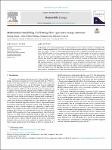Mathematical modelling of a floating Clam-type wave energy converter
| dc.contributor.author | Zheng, Siming | |
| dc.contributor.author | Phillips, JW | |
| dc.contributor.author | Hann, Martyn | |
| dc.contributor.author | Greaves, Deborah | |
| dc.date.accessioned | 2023-05-04T11:29:52Z | |
| dc.date.available | 2023-05-04T11:29:52Z | |
| dc.date.issued | 2023-07 | |
| dc.identifier.issn | 0960-1481 | |
| dc.identifier.issn | 1879-0682 | |
| dc.identifier.uri | https://pearl.plymouth.ac.uk/handle/10026.1/20788 | |
| dc.description | File replaced (published version) on 5.5.23 by NK (LDS) | |
| dc.description.abstract |
In this paper, wave power extraction from a floating Clam-type wave energy converter is investigated. The device is mainly composed of a Clam, which is formed from two pieces of floating flaps hinged at a submerged body. The Clam is closed by a flexible impermeable bag with the two hinged floating flaps kept apart by a Power Take-Off system. As waves propagate through the device, the Clam motion of the device is excited, which can be used to drive the Power Take-Off system to capture wave power. To evaluate the response and also the wave power absorption of the device, a mathematical model is developed based on the linear potential flow theory, in which a generalised mode method is adopted to model the Clam action. Theoretical expressions of the maximum wave power absorption and the corresponding optimised Power Take-Off system and mooring parameters are derived. Good agreement between the present numerical results of the device response and the physical observations is obtained. The validated model is then applied to do a series of case studies. It is revealed that the optimised Power Take-Off stiffness and mooring stiffness are independent of the Power Take-Off damping. The maximum wave power absorption can be achieved when the device is fixed in heave mode or free-floating without any constraints from the mooring system. | |
| dc.format.extent | 280-294 | |
| dc.language | en | |
| dc.publisher | Elsevier BV | |
| dc.subject | Wave-structure interaction | |
| dc.subject | Potential flow theory | |
| dc.subject | Clam-type wave energy converter | |
| dc.subject | Boundary element method | |
| dc.subject | Generalised mode method | |
| dc.title | Mathematical modelling of a floating Clam-type wave energy converter | |
| dc.type | journal-article | |
| dc.type | Journal Article | |
| plymouth.author-url | https://www.webofscience.com/api/gateway?GWVersion=2&SrcApp=PARTNER_APP&SrcAuth=LinksAMR&KeyUT=WOS:000985862700001&DestLinkType=FullRecord&DestApp=ALL_WOS&UsrCustomerID=11bb513d99f797142bcfeffcc58ea008 | |
| plymouth.volume | 210 | |
| plymouth.publication-status | Published | |
| plymouth.journal | Renewable Energy | |
| dc.identifier.doi | 10.1016/j.renene.2023.04.040 | |
| plymouth.organisational-group | |Plymouth | |
| plymouth.organisational-group | |Plymouth|Research Groups | |
| plymouth.organisational-group | |Plymouth|PRIMaRE Publications | |
| plymouth.organisational-group | |Plymouth|Faculty of Science and Engineering | |
| plymouth.organisational-group | |Plymouth|Faculty of Science and Engineering|School of Engineering, Computing and Mathematics | |
| plymouth.organisational-group | |Plymouth|Research Groups|Marine Institute | |
| plymouth.organisational-group | |Plymouth|REF 2021 Researchers by UoA | |
| plymouth.organisational-group | |Plymouth|Users by role | |
| plymouth.organisational-group | |Plymouth|Users by role|Academics | |
| plymouth.organisational-group | |Plymouth|REF 2021 Researchers by UoA|UoA12 Engineering | |
| plymouth.organisational-group | |Plymouth|Users by role|Researchers in ResearchFish submission | |
| plymouth.organisational-group | |Plymouth|Research Groups|COAST Engineering Research Group | |
| dcterms.dateAccepted | 2023-04-11 | |
| dc.date.updated | 2023-05-04T11:29:52Z | |
| dc.rights.embargodate | 2023-5-6 | |
| dc.identifier.eissn | 1879-0682 | |
| dc.rights.embargoperiod | forever | |
| rioxxterms.versionofrecord | 10.1016/j.renene.2023.04.040 |


